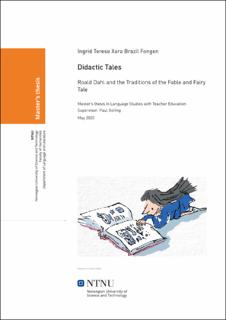Didactic Tales: Roald Dahl and the Traditions of the Fable and Fairy Tale
Master thesis
Permanent lenke
https://hdl.handle.net/11250/2781864Utgivelsesdato
2020Metadata
Vis full innførselSamlinger
Sammendrag
Denne analysen av verkene til Roald Dahl, med henvisninger til Grimm-brødrenes eventyr og Æsops fabler, tar stilling til de didaktiske elementene i barnelitteratur. Det finnes mange forbindelser mellom Dahl og verkene til Grimm-brødrene og Æsop, både gjennom direkte referanser til eventyr og ved gjennomgående tematikk som karaktertrekk, avslutninger, det overnaturlige og antropomorfisme. Dahls romaner inkluderer tilpassede elementer fra eventyr, som igjen inneholder tilpassede elementer fra fabelen. I likhet med fabler og eventyr kan Dahls verk anses som moralistiske, hvilket denne oppgaven argumenterer for. Moralistiske elementer i Dahl inkluderer protagonistens integritet, belønninger for moralske personer, og straffelse av skurken. Teknikkene som er brukt til å implementere ønskede moralske verdier i leseren er hovedsakelig humor og skrekkelementer. Ofte er Dahls verk både skremmende og morsomme; verkene veksler mellom å oppmuntre og skremme barn til å oppføre seg i henhold til sosiale normer. Denne masteroppgaven argumenterer at å skremme barn til å oppføre seg bygger på ytre motivasjon siden barnet oppfører seg pent for å unnslippe straff. Denne formen for didaktikk kan anses som gammeldags og utdatert, og dermed setter spørsmålstegn ved hvorvidt didaktikken i Dahls verk er passende i det moderne samfunn. This analysis of the works of Roald Dahl with reference to the Grimm brothers’ fairy tales and Aesop’s fables evaluates the didactic elements in children’s literature. There are many connections between Dahl and the works of the Grimms and Aesop, both by direct references to fairy tales and through recurring themes such as character traits, endings, the supernatural, and anthropomorphism. Dahl’s novels include adapted elements of the fairy tale, which in turn includes adapted elements of the fable. Like fables and fairy tales, Dahl’s works may be seen as moralistic, as this thesis argues. Moralistic elements found in Dahl include the integrity of the protagonist, rewards for the morally “good”, and punishment of the villain. The techniques used to implement the desired moral values in the reader are mostly humor and horror. Dahl’s works are often both horrifying and humorous; his works tread a fine line between encouraging and frightening children into behaving according to social norms. This thesis argues that scaring children into behaving properly builds on extrinsic motivation, since the child will behave well in order to escape punishment. This type of didacticism may be considered old-fashioned and out of date, and thus brings into question the suitability of the didactics in Dahl’s novels in modern society.
